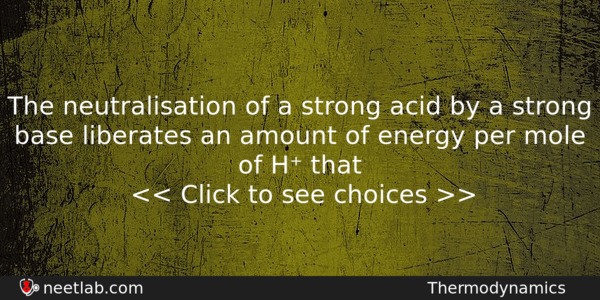| ⇦ | 
| ⇨ |
The neutralisation of a strong acid by a strong base liberates an amount of energy per mole of H⁺ that
Options
(a) depends upon which catalyst is used
(b) depends upon the temperature at which the reaction takes place
(c) depends upon which acid and base are involved
(d) is always is same
Correct Answer:
is always is same
Explanation:
Strong acids and strong base dissociate completely in solution to give H⁺ and OH⁻ in solution.
e.g. NaOH → Na⁺ + OH⁻,
HCl → H⁺ + Cl⁻. So the amount of energy liberated is always the same, as the reaction involved is , H⁺ + OH⁻ → H₂O.
Related Questions: - In which process,fused sodium hydroxide is eletrolysed at a 330⁰C temperature
- Role of hydrogen peroxide in the above reactions is respectively
- Benzoic acid,when heated with soda lime yields
- The rate of reactions exhibiting negative activation energy
- Which of the following statements about H₃BO₃ is not correct
Topics: Thermodynamics
(179)
Subject: Chemistry
(2512)
Important MCQs Based on Medical Entrance Examinations To Improve Your NEET Score
- In which process,fused sodium hydroxide is eletrolysed at a 330⁰C temperature
- Role of hydrogen peroxide in the above reactions is respectively
- Benzoic acid,when heated with soda lime yields
- The rate of reactions exhibiting negative activation energy
- Which of the following statements about H₃BO₃ is not correct
Topics: Thermodynamics (179)
Subject: Chemistry (2512)
Important MCQs Based on Medical Entrance Examinations To Improve Your NEET Score
18000+ students are using NEETLab to improve their score. What about you?
Solve Previous Year MCQs, Mock Tests, Topicwise Practice Tests, Identify Weak Topics, Formula Flash cards and much more is available in NEETLab Android App to improve your NEET score.
Share this page with your friends

Leave a Reply